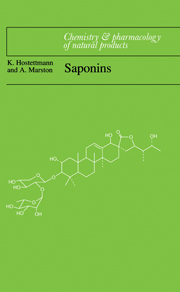Book contents
- Frontmatter
- Contents
- Glossary
- 1 Introduction
- 2 Occurrence and distribution
- 3 Analysis and isolation
- 4 Structure determination
- 5 Triterpene saponins – pharmacological and biological properties
- 6 Steroid saponins and steroid alkaloid saponins: pharmacological and biological properties
- 7 Commercially important preparations and products
- Appendices
- References
- Index of Latin names
- General index
2 - Occurrence and distribution
Published online by Cambridge University Press: 19 October 2009
- Frontmatter
- Contents
- Glossary
- 1 Introduction
- 2 Occurrence and distribution
- 3 Analysis and isolation
- 4 Structure determination
- 5 Triterpene saponins – pharmacological and biological properties
- 6 Steroid saponins and steroid alkaloid saponins: pharmacological and biological properties
- 7 Commercially important preparations and products
- Appendices
- References
- Index of Latin names
- General index
Summary
Saponins are extremely widely distributed in the plant kingdom. Even by 1927, Kofler had listed 472 saponin-containing plants (Kofler, 1927) and it is now known that over 90 families contain saponins. Gubanov et al. (1970) found, in a systematic investigation of 1730 central Asian plant species, that 76% of the families contained saponins.
Saponins occur in plants which are used as human food: soybeans, chick peas, peanuts, mung beans, broad beans, kidney beans, lentils, garden peas, spinach, oats, aubergines, asparagus, fenugreek, garlic, sugar beet, potatoes, green peppers, tomatoes, onions, tea, cassava, yams (Birk and Peri, 1980; Oakenfull, 1981; Price et al. 1987) and in leguminous forage species (such as alfalfa). Kitagawa (1984) has described the isolation of soyasaponin I (454, Appendix 2) from a number of forage and cover crops, including Trifolium spp., Medicago spp., Astragalus spp. and Vicia sativa. Finally, saponins are also present in numerous herbal remedies (see Chapter 7).
Saponin content depends on factors such as the cultivar, the age, the physiological state and the geographical location of the plant. There can be considerable variation in composition and quantity of saponins in vegetable material from different places, as documented for Lonicera japonica (Caprifoliaceae) (Kawai et al. 1988).
The saponin distribution among the organs of a plant varies considerably. In the garden marigold (Calendula officinalis, Asteraceae), for example, saponins with a glucuronic acid moiety at C-3 of oleanolic acid are found in the flowers, while a glucose moiety at the same position is found in the saponins from the roots (Lutomski, 1983; Vidal-Ollivier et al. 1989a,b). The flowers contain 3.57% saponins, while the roots have 2.55% of their dry weight in the form of saponins (Isaac, 1992).
- Type
- Chapter
- Information
- Saponins , pp. 18 - 121Publisher: Cambridge University PressPrint publication year: 1995
- 1
- Cited by

